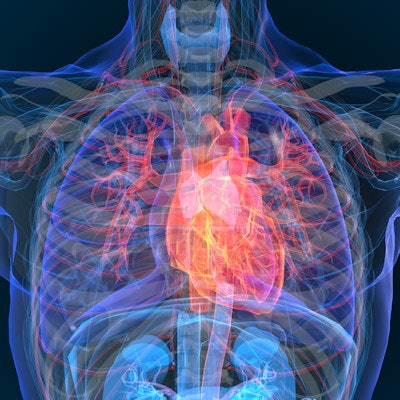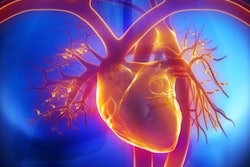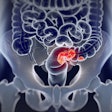
A nomogram that includes a variety of coronary CT angiography (CCTA) factors improves the modality's ability to predict future adverse cardiovascular events, a study published March 23 in Medical Physics has found.
The study results suggest that there's a noninvasive, relatively easy imaging option for monitoring patient risk of major heart events, wrote a team led by Dr. Jie Wang of the Affiliated Wuxi People's Hospital of Nanjing Medical University, in Wuxi, China.
"[Our] multiparameter CCTA model has improved performance in predicting major adverse cardiac events," the group wrote. "[A] nomogram for predicting major adverse cardiac events ... represents a practical and easy-to-use method in the clinical setting."
Predicting risk of major adverse heart events -- such as heart failure, nonfatal heart attack, recurrent angina pain, hospitalization for heart-related illness, coronary artery bypass grafting, and all-cause mortality -- is crucial for individuals suspected of having cardiovascular disease. Clinicians tend to track factors such as symptoms, electrocardiography results, and blood tests, but these have poor prognostic power -- which prompts a need for a better way to gauge patient risk. That's where coronary CT angiography could help.
"CCTA is a noninvasive imaging tool that can provide useful information about the anatomy of the coronary artery," the authors noted. "With the continuous improvement of computer software, different parameters can be obtained by CCTA, including stenosis, qualitative and quantitative plaque analysis, and fractional flow reserve derived from CCTA."
The group sought to create a multiparameter nomogram for coronary CT angiography that would improve prediction of heart-damaging incidents. To do so, researchers conducted a study that included 483 heart vessels in 260 patients who underwent CCTA and presented with a major adverse cardiac event between 90 days and two years after the exam. The researchers analyzed the presence of CCTA stenosis, qualitative and quantitative plaque characteristics, and fractional flow reserve derived from coronary CT angiography (FFRct).
They found that the combination of the following CCTA features showed higher predictive value of major adverse cardiac events, with an area under the receiver operating curve of 0.92:
- Stenosis on CCTA
- Plaque qualitative-quantitative characteristics
- Fractional flow reserve
This mix of CCTA features was more predictive than CCTA stenosis alone; fractional flow reserve alone; plaque qualitative-quantitative characteristics alone; coronary CT angiography stenosis combined with plaque qualitative-quantitative characteristics; and coronary CT angiography stenosis combined with fractional flow reserve, the authors explained.
The nomogram model that came out of these findings could improve patient care by offering a more reliable way to predict major cardiac incidents in people vulnerable to heart disease, according to Wang and colleagues.
"In this study, the CCTA multiparameter model established through large sample data was of great value for predicting major adverse cardiac events," they wrote. "Moreover, we created a nomogram for prediction, which was visual, simpler, and more intuitive, [and is] promising for clinical application."





















